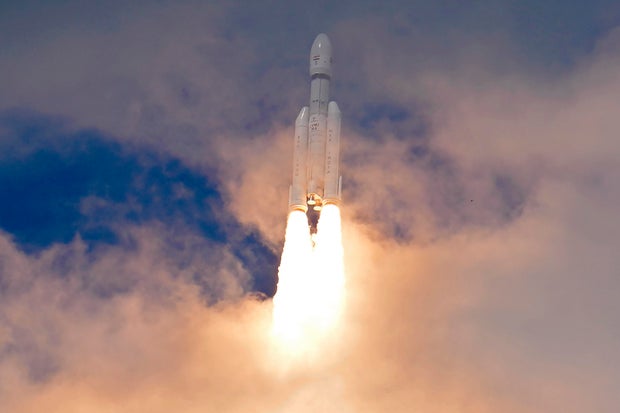India’s Chandrayaan-3 moon mission takes off with a successful launch as rocket hoists lunar lander and rover
New Delhi — Scientists with India’s space program erupted with joy on Friday as a massive rocket lifted off with a bang and tore through the clouds, carrying an unmanned spacecraft on a mission to land on the dark side of the moon. A LVM3-M4 heavy-lift rocket carried the Chandrayaan-3 spacecraft, with its lunar lander and small rover, away from the Satish Dhawan Space Centre in Sriharikota, southern India, at 2:35 p.m. local time on Friday without a hitch.
It was a “text-book launch” as the rocket successfully delivered Chandrayaan-3 into orbit, scientists from the Indian Space Research Organization (ISRO) said.
Aijaz Rahi/AP
Chandrayaan-3 is the country’s third lunar exploration mission and scientists are hoping for a soft landing near the moon’s little-explored south pole in the months ahead.
It is India’s second attempt to land on the moon’s surface. In 2019, India’s second lunar probe, Chandryaan-2, failed, with a heart-breaking crash of its lander on the moon’s surface. The orbiter from the Chandrayaan-2 mission is still in lunar orbit and continues to send back data on the moon’s atmosphere today. That information will be used by Chandrayaan-3 in the current mission.
The spacecraft’s journey to the moon should take about 40 days, with the landing attempt expected on August 23. If the landing is successful, India will join an elite club currently made up of just three countries — the United States, Russia and China — that have pulled off successful moon landings.
If the lander touches down safely, the rover will explore the moon’s surface for one lunar day, or approximately 14 Earth days, to collect scientific data on our nearest celestial body’s composition.
“Chandrayaan-3 scripts a new chapter in India’s space odyssey. It soars high, elevating the dreams and ambitions of every Indian,” Indian Prime Minister Narendra Modi wrote on Twitter after the launch. “This momentous achievement is a testament to our scientists’ relentless dedication. I salute their spirit and ingenuity!”
India’s first mission, 13 years ago, was a huge success as scientists said their lunar orbiter had detected water molecules around the moon’s south pole. It was the first evidence of water there – a discovery that startled scientists globally and raised hopes of the possibility of sustaining human life on moon in future.
India’s moon missions are seen as a demonstration of the country’s growing space prowess.
ISRO chief Sreedhara Panicker Somanath said the space agency had studied data from the last crash and used it to improve their lander.
Chandrayaan-3 weighs about 4.3 tons in total. The lander, called Vikram, weighs about 3,300 pounds and carries the rover, named Pragyaan, which weighs less than 60 pounds.
Pallava Bagla/Getty
“The rover is carrying five instruments which will focus on finding out about the physical characteristics of the surface of the moon, the atmosphere close to the surface and the tectonic activity to study what goes on below the surface,” Somanath told an Indian news outlet. “I’m hoping we’ll find something new.”
ISRO said the lander and rover were fitted with sensors and other high-tech instruments designed to carry out experiments and collect data on the chemical composition of lunar soil, measure any seismic activity, and measure the thermal properties of the lunar surface near its south pole.
Millions of Indians watched the spectacular launch of the rocket live on TV and social media platforms. Many described it as “a moment of pride, glory and joy,” while some said they got “goosebumps” watching the rocket lift off.
For all the latest Automobiles News Click Here
For the latest news and updates, follow us on Google News.



